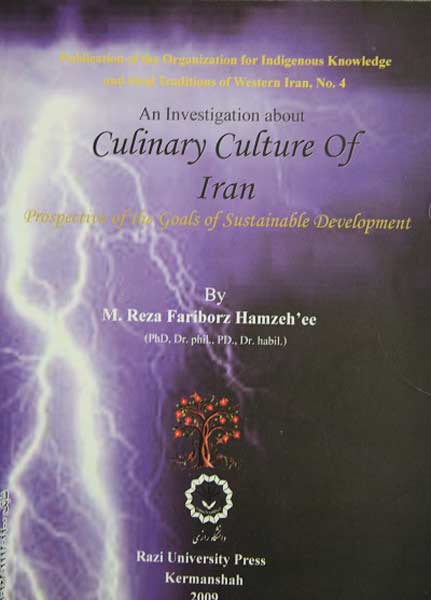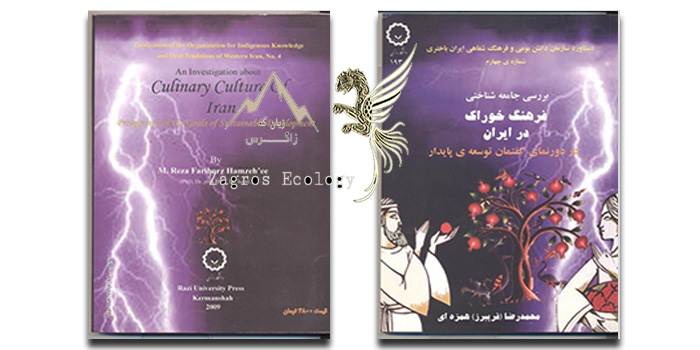book introduction
An investigation about culinary culture of Iran
An investigation about culinary culture of Iran perspective of the sustainable development by M. Reza Fariborz Hamzeh’ee. Razi University Press Kermanshah
Culinary culture in general is a new discovered field for the scholars of different scientific fields. In the field of material culture, most of human activities are related to three main basic needs: most important of these three being nutrition and the other two being clothing or covering as well as housing.
Being only few decades old, the study of culinary culture has attracted researchers of different branches of science. Claudia Roden (1994) who is one of the pioneers in the study of culinary culture writes:
“Long disdained, even in the field of women’s studies, as too domestic and ordinary, the study of food has at last won legitimacy in the academic world. It is now a hot subject that attracts many different kinds of specialists – historians, sociologists, anthropologists, geographers, political economists, literary scholars and philosophers. Cooking and eating are seen as important human activities that can reveal much about the life and societies in the past as well as in the present. It is a wonder that it has taken so long for this to be recognized. After all, everyone eats and nearly half of us cook, whereas not everybody plays a musical instrument or paints or makes pots, and these activities have long been the subject of specialist studies.”
One of the earliest comprehensive investigations aiming at scientific analysis of culinary was performed by Jack Goody with the title: “Cooking, Cuisine and Class: a Study in Comparative Sociology”, which was published in 1982.
An investigation about culinary culture of Iran
According to Goody, culinary culture of the Middle East is one of the most developed in the whole world; next to China and only for a certain period of time to that of Europe. The above mentioned Claudia Roden is after all regarded as a pioneer in the field of Middle Eastern cuisine because of her research which was published in 1968; whereas a collection of different analytical investigations of culinary culture of the same region was published in 1994 by Sami Zubaida and Richard Tapper.
All the scholars of the culinary culture agree that the archetype of the culinary culture of the Middle East – whether Arabic, Turkish or Iranian- is that of Sassanid (224-642 A.C.). This as a whole was adopted by the Abbasids (750-1258 A.C.) in the early Islamic periods. Like other nomadic dynasties, the Abbasid not only built its capital, Baghdad, near to the ruins of Sassanid capital Ctesiphon, but also their predecessors while almost completely adopting their habits.
During the first century of their rule all the Sassanid and even some Byzantine books and pamphlets were collected in several collections and became main sources for all other books in the later centuries.The culinary traditions being only one of the cultural aspects revived and continued by the Abbasids; even the kitchen were managed and manned practically by the same families which used to serve the Sassanid high class.
Although both Ottoman (1299- 1922 A.C.) and Safavid (1501/1502-17722 A.C.) high cookeries were the continuation of the same tradition, in rigid political border between these two rivaling empires, became a dividing line between two different culinary developments.
culinary culture of Iran
With the westward expansion of the Ottoman, they came to have more transaction with Europe and North Africa. On the one hand they were influenced by the culinary traditions of those parts of the world, whereas influencing their culinary on the other. The Turks, who had been instrumental in spreading Sassanid cultural elements, also took the originally Sassanid culinary culture to different parts of Europe and North Africa. Safavids who were deprived of cultural contact with Europe received several influences through their eastern borders, from as far as China, but determined the Mughal culinary culture of North India.
The Sassanid material and non-material culture has been the source of Middle Eastern civilizations throughout centuries until today. Although this is relatively known to the scholars, in most cases the subjects are scientifically under-studies or even neglected. Among these neglected fields, culinary culture is not an exception.
Until now very little has been published about Iranian culinary culture except few short article, some of which being included in the above mentioned book edited by Zubaida and Tapper.
Razi University Press Kermanshah
The present book would therefore be a first attempt to relatively make a comprehensive study of Iranian culinary culture, performed in the field of sociology of culture. With the help of secondary sources, it is tried to show the importance of the Sassanid culinary culture as the original source for shaping that of the Middle East in later periods. It is therefore attempted to underline an issue upon which all European scholars agree.
First of all, this study follows Goody’s line of analytical discussion. He makes a difference between the hierarchic societies of the Middle East and hieratic societies of Africa. Truly as emphasized by Goody, almost all high cuisines have been developed in the societies with long standing hierarchic political and economic structures. However, in this comparison with African societies, he notices that in Africa- even in societies with hierarchic structure – a high and differentiated cuisine was not developed.
An investigation about culinary culture
Inspired by Goody’s observation, it was tried to find out what factors might have been involved in causing Sassanid culinary culture to develop in such a fascinating manner. To achieve this goal, comparative methods of research based on secondary sources as well as collected field material, was followed.
On the basis of material collected among the Yaresan Kurds as well as Zoroastrian community of Yazd, the first impression was striking similarities between the rituals performed by these two different communities. Despite previous knowledge of the researcher about the rituals, the discovery about the similarity was made only after direct participation in most rituals performed among these two communities. Field material made it evident that these communities are elaborately ritualistic. Moreover the most important characteristics of these rituals are that they are to a great extent based on culinary symbolism.
Compared to most other cultural phenomena, culinary culture should be considered as the most archaic and conservative and long living. Therefore in this way much can be understood about that part of Sassanid religious system, about which no historical or other evidences or reports exist. Therefore it is concluded that Sassanid religion must have been an elaborately ritualistic one, based on culinary symbolism. New archeological discoveries show that the ancient Iranian religions have been of the same type; at least since the Achaemenids (550-330 B.C.).
Consequently it is argued that the ritualistic nature of Iranian religions must have contributed to the development of their culinary culture. In short, such culinary ritual in addition to the hierarchic nature of the society- made Sassanid culinary culture to develop in such a fascinating manner. Despite of that, there could have been many other factors – in addition to these two – which were involved in this process.
In summary, the first part of the investigation attempts to show:
Firstly considering the surviving ancient rituals still practiced among the contemporary communities as well as different evidences found in religious and historical sources, lead to the assumption that the Sassanid religion must have been elaborately ritualistic one.
Secondly in the ancient rituals, sacrifices and offerings have – as among the communities of today- played a main role. But more interesting, culinary symbolism were not the end in themselves, rather the ritual food was prepared in order to be distributed among the participants to be consumed during the ceremony or taken home to be consumed in another occasions.
As of now, these rituals used to be held very frequently, making individual prayers a less important religious duty.
At it is also observed in musical or architectural field, often religiously motivated material and non-material cultural activities have resulted in extra ordinary achievements. Therefore the religiously motivated culinary culture of Sassanid has certainly been contributing to its high level of development.
M. Reza Fariborz Hamzeh’ee
In addition to this hypothesis regarding ancient Iranian culture, the second part of the study moves into the field of applied sociology. The major purpose of this part is to increase ecological awareness of a wider audience in relation to the culinary activities. It relates the analytical discussions of the first part to the actual findings about the existing ecological crisis.
Being one of the first investigations of its kind in Persian language, the author has knowingly provided different actual information to contribute to the development of the culture of sustainability. Whereas the first capital may help to increase knowledge regarding rich Iranian culinary culture, the second capital aims at the ecological and human consequence of conscious consumption by individual actors. In this way a conscious social action is seen as a part of both social and individual responsibility. This is therefore pointed out that in this field these two types of responsibilities are not contradicting, but complementing each other leading to a general culture of sustainability.
Since culture has an important role in sustainable development, this investigation makes developing culinary awareness one of its main practical goals.
Preface An investigation about culinary culture of Iran in PDF format

An investigation about culinary culture of Iran
perspective of the sustainable development
M. Reza Fariborz Hamzeh’ee
(PhD., Dr. phil., PD., Dr.habil.)
Razi University Press
Kermanshah
2009
Culinary Culture of the Kurds by Fariborz Hamzehee vol I
Kurdish Cuisine by Fariborz Hamzehee vol II
An interdisciplinary investigation about history and culture of Harsin

 فارسی
فارسی
